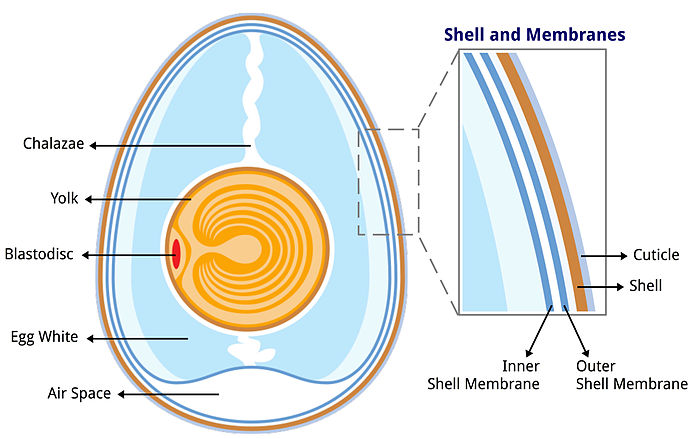The egg, certainly. The first animals on earth, probably the sponges, reproduced both sexually and asexually. They simply grew a bud that became a new individual or they produced eggs and sperm. So perhaps as far back as 500 million years or more, there were eggs. Chickens didn’t arrive on the scene until about 58,000 years ago.
The egg. In a truly amazing 24 hours, a bird produces a fully formed, shell-covered egg with a tiny embryo inside.
First, the ovum or oocyte- the egg cell, covered with yolk moves from the ovary into the hen’s abdominal cavity. This is ovulation. The infundibulum, a funnel-shaped structure of the oviduct, quickly engulfs the yolk. The yolk then enters the magnum of the oviduct where most of the albumen (egg white) is added.

Passing from the magnum into a narrower part of the oviduct called the isthmus, the two shell membranes form. The shell membranes contain the yolk and white until the rest of the albumen is added in the uterus.
The shell is also added in the uterus of the oviduct. The shell is composed mainly of calcium carbonate deposited on a protein matrix. You can demonstrate this yourself by putting a chicken egg in a jar of vinegar. In a few hours the vinegar will have dissolved the calcium carbonate shell, leaving a rubbery egg whose contents are contained by the matrix.
It takes about 20 hours for the eggshell to form. It is a semipermeable membrane that allows air and moisture to pass through its tiny pores, as many as 17,000. Between the eggshell and albumin, two transparent membranes form which protect against bacterial invasion.
In the last phase of eggshell formation, color and texture is laid down. Although some people prefer brown eggs to white ones, there is no nutritional difference in brown and white eggs — egg color simply depends on the breed of the chicken. For example, White Leghorn chickens lay white-shelled eggs, while Plymouth Rocks and Rhode Island Reds lay brown-shelled eggs. Some breeds of chicken such as the Araucana even lay blue or blue-green eggs.

The chalazae, two cord-like structures which keep the yolk centered in the egg, are formed in the uterus. Chalazae are those white lumps you see when you crack an egg open. The chalazae function as an axis around which the yolk can rotate and keep the blastodisc (the embryo) in hatching eggs uppermost at all times. The mother bird turns the eggs so that the growing embryo gets enough albumin which provides protein and water.
In the last portion of the oviduct the egg is oriented small end first but is turned horizontally just before laying so that it passes through to the outside large end first. If the hen is disturbed on the nest, the egg may be prematurely laid small end first.
The bloom is the protective layer covering the eggshell and is the last layer added in egg formation. It is added right before it exits from the hen’s vent/vagina. This coating seals out bacteria and maintains the moisture inside the egg.
Then incubation begins egg development. The Poultry Site has a very good explanation with vivid illustrations.
Also, see my blog on the mysteries of the egg.